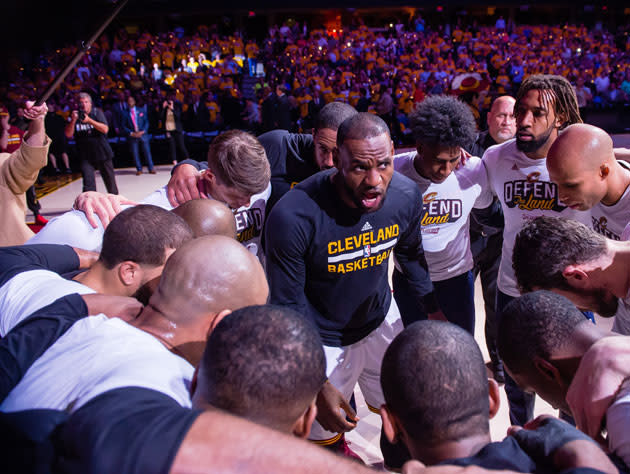Study: 'LeBron effect' upticks 'very local' business ownership 13 percent, employment 23 percent

When the Cleveland Cavaliers secured $140 million in public funds for its home arena in April, the clatter was well-earned.
[Follow Ball Don’t Lie on social media: Twitter | Instagram | Facebook | Tumblr]
The Cavs, led by a billionaire owner and well-heeled group of show-me helpers, hardly appeared to need the $88 million Cleveland itself pledged toward upgrades on Quicken Loans Arena, but civic-strong local business leadership and sound government practices often tend to fall in the face of something as “significant” as sports.
Unexpectedly, a recent report from the right-leaning American Enterprise Institute pegged LeBron James’ contribution to the local economy using the same terms, noting that an increase in activity has taken hold outside both Miami’s American Airlines Arena and Cleveland’s arena during his time with both the Heat and his return to the Cavaliers:
We find that Mr. James has a statistically and economically significant positive effect on both the number of restaurants and other eating and drinking establishments near the stadium where he is based, and on aggregate employment at those establishments.
Specifically, his presence increases the number of such establishments within one mile of the stadium by about 13%, and employment by about 23.5%. These effects are very local, in that they decay rapidly as one moves farther from the stadium.
The report acknowledged what it called the “quasi-consensus among economists” around the time of a different 2008 study, prior to LeBron’s two free agent turns, one that reminded us “that professional sports franchises and facilities do little to nothing to help local economic development, income growth, or job creation.”
The AEI report attempts to dismiss as much, revealing findings that “show a downward trend in the number of restaurants in Cleveland between 2010 and 2014 that coincides with an upward trend in Miami.”
“After Mr. James returned to the Cavaliers, the number of restaurants near the Quicken Loans Arena in Cleveland spiked, while the number of restaurants within a mile of the American Airlines Arena started to slide.
“Figure 2 shows some suggestive evidence on the mechanism underlying these patterns: there is a positive correlation between the number of regular-season wins won by the Cavaliers and the Heat and the number of restaurants located within one mile of the corresponding stadium.”
You reckon?
Not only were the Cleveland Cavaliers of 2010-14 LeBron-less and charmless, the team represented a cynical attempt by Cavs ownership (and former front office) at replicating James’ 60-win, championship contender-status in the city, yet without the presence of a performer who should retire as the greatest player in basketball history.
It’s hardly a shock that Cleveland punters couldn’t be roused into spending extra cash at restaurants within a short walk of the Cavaliers’ arena when Antawn Jamison and Jamario Moon were the team’s top 2010-11 draws (save for the idiots that ran onto the Cavaliers court), or when Kyrie Irving missed 23 games in his second year, or when the team tried out Anthony Bennett AND Andrew Bynum on the same club, with Byron Scott and Mike Brown coaching throughout.
Furthermore, the great pains the report takes to emphasize its conclusion that the “superstar effect” dies out almost immediately past walking distance of the arenas LeBron James plays in.
The arenas LeBron James plays in.
The findings are as unsurprising as the impetus for and timing of the report. LeBron James is a once-in-generation superstar that fans would take buses to (provided a keg sits, accessible to anyone with a plastic cup, in the back) watch play. Just as each of the NBA’s 30 teams sends itself into conniptions trying to either secure or sustain the employment of one of the league’s five or six franchise-tilting superstars, communities seek out the same.
A 23 percent raise in employment is hardly anything to sneeze at, neither are those out-of-town dollars and the perpetual promise of dates to count on until June each year, rather than mid-April. Nobody should sensibly attempt to deny that the impact of LeBron James, on or off the court, is negligible.
It’s a small tick, though, just a mile outside the arena. The same increase also cannot be counted on in cities featuring the type of sub-LeBron stars that James typically vanquishes on his way toward the NBA Finals each year. Especially when we remember that this with-James comparison comes in reflection of sub-standard Cleveland clubs without LeBron, and in a Miami setting that hardly needs the help in making the Heat’s arena an infrequent destination.
And the debate as to whether any of this should inspire community leaders to agree with sports team owners that their arenas should be upgraded on the taxpayers’ dime ended long, long ago.
– – – – – – –
Kelly Dwyer is an editor for Ball Don’t Lie on Yahoo Sports. Have a tip? Email him at KDonhoops@yahoo.com or follow him on Twitter!


